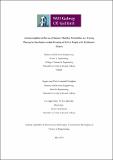| dc.contributor.advisor | Ó Laighin, Gearóid | |
| dc.contributor.advisor | Quinlan, Leo | |
| dc.contributor.author | Sweeney, Dean | |
| dc.date.accessioned | 2022-03-23T14:22:40Z | |
| dc.date.issued | 2021-05-04 | |
| dc.identifier.uri | http://hdl.handle.net/10379/17054 | |
| dc.description.abstract | People with Parkinson’s (PwP) currently face a significant challenge in managing on-state Freezing of Gait (FoG).
While auditory and visual cueing therapies have been shown to ameliorate on-state FoG, studies often show heterogeneity in their results. These therapies, inevitably, are associated with practical challenges for the PwP when using the therapy, while completing daily living tasks that require the use of vision or hearing to execute the task safely and effectively. There is also an unmet need to provide a cueing therapy that can be easily concealed and thus eliminate the potential for the social stigma associated with wearing visible assistive technology in a public setting.
We set out to develop a new cueing therapy that overcomes the practical limitations of auditory and visual cueing therapies while at the same time ensuring our developed cueing therapy technology is usable to the greatest extend by PwP.
This was achieved by progressively exploring the efficacy of sensory electrical stimulation (sES) as a cueing therapy, while adopting a Human-Centred Design cycle throughout the development process and thus carrying out a series of evaluation studies with clinical collaborators.
The first study was carried out in Scotland and evaluated the efficacy of a Continuous sES cueing strategy. Although limited in participants (n=9), this pilot study indicated that a sES cueing strategy, delivering continuously in a ‘fixed’ rhythmic manner on the upper leg, could reduce the time to complete a walking task by 14% and the number of FoG episodes occurring by 58%. An additional pilot study with 10 participants was carried out in Ireland, investigating self-activated On Demand sES cueing. However, the study results were discouraging as it was demonstrated that On-Demand sES cueing did not affect the duration of FoG episodes.
The third study, with 12 participants, directly evaluated the efficacy of our Continuous sES cueing strategy to auditory and visual cueing devices. Compared to baseline (not wearing a cueing device), the results showed visual cueing had noXII effect, while both Continuous sES and auditory cueing reduced the percentage of time the PwP were in FoG by 55 ± 25% and 69 ± 24%, respectively.
In the final study, a Multi-faceted Continuous sES cueing strategy was evaluated on 10 participants. The Multi-faceted Continuous sES cueing strategy delivered sES continuously on both upper legs, in a rhythmic manner scaled to each participant’s step rate. Compared to baseline (not wearing the sES cueing device), the results indicated that Multi-faceted Continuous sES cueing reduced the percentage of time the PwP were in FoG and the number of FoG episodes occurring by 72 ± 25% and 52 ± 31%, respectively.
Comparing the efficacy of the Multi-faceted Continuous sES cueing strategy to previous results would suggest that it performs favourably with auditory and visual cueing therapies. Furthermore, the sES cueing system frees the primary senses of vision or hearing, enabling the PwP to complete daily living tasks in a safer manner. | en_IE |
| dc.publisher | NUI Galway | |
| dc.rights | Attribution-NonCommercial-NoDerivs 3.0 Ireland | |
| dc.rights | CC BY-NC-ND 3.0 IE | |
| dc.rights.uri | https://creativecommons.org/licenses/by-nc-nd/3.0/ie/ | |
| dc.rights.uri | https://creativecommons.org/licenses/by-nc-nd/3.0/ie/ | |
| dc.subject | Freezing of Gait | en_IE |
| dc.subject | Parkinson's Disease | en_IE |
| dc.subject | Sensory Electrical Stimulation | en_IE |
| dc.subject | Cueing | en_IE |
| dc.subject | Science and Engineering | en_IE |
| dc.subject | Engineering | en_IE |
| dc.subject | Electrical & Electronic Engineering | en_IE |
| dc.title | An investigation on the use of sensory electrical stimulation as a cueing therapy to ameliorate on-state freezing of gait in people with Parkinson's Disease | en_IE |
| dc.type | Thesis | en |
| dc.contributor.funder | Seventh Framework Programme | en_IE |
| dc.contributor.funder | Science Foundation Ireland | en_IE |
| dc.local.note | The work outlined in this thesis explored the design of an sensory electrical stimulation cueing system and detailed a collection of clinical studies that progressively investigated the efficacy of three different cueing strategies to ameliorate freezing of gait in Parkinson’s disease. | en_IE |
| dc.description.embargo | 2026-01-31 | |
| dc.local.final | Yes | en_IE |
| dcterms.project | info:eu-repo/grantAgreement/EC/FP7::SP1::ICT/287677/EU/Personal Health Device for the Remote and Autonomous Management of Parkinson’s Disease/REMPARK | en_IE |
| nui.item.downloads | 0 | |


